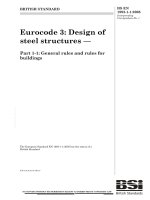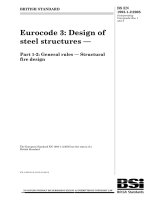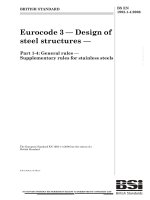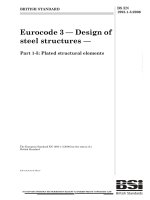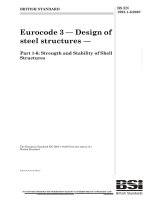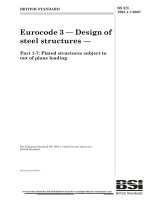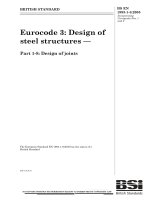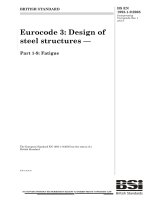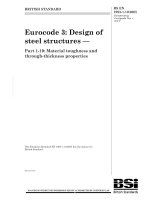Tiêu chuẩn Châu Âu EC8: Kết cấu chống động đất phần 2: Thiết kế cầu (Eurocode8 BS EN1998 2 e 2005 Design of structure for earthquake resistance part 2:Bridges)
Bạn đang xem bản rút gọn của tài liệu. Xem và tải ngay bản đầy đủ của tài liệu tại đây (2.99 MB, 152 trang )
BRITISH STANDARD
Eurocode 8 — Design of
structures for
earthquake
resistance —
Part 2: Bridges
The European Standard EN 1998-2:2005 has the status of a
British Standard
ICS 91.120.25; 93.040
12 &23<,1* :,7+287 %6, 3(50,66,21 (;&(37 $6 3(50,77(' %< &23<5,*+7 /$:
BS EN
1998-2:2005
BS EN 1998-2:2005
National foreword
This British Standard is the official English language version of
EN 1998-2:2005. It supersedes DD ENV 1998-2:1996 which is withdrawn.
The structural Eurocodes are divided into packages by grouping Eurocodes for
each of the main materials, concrete, steel, composite concrete and steel,
timber, masonry and aluminium. This is to enable a common date of
withdrawal (DOW) for all the relevant parts that are needed for a particular
design. The conflicting national standards will be withdrawn at the end of the
coexistence period, after all the EN Eurocodes of a package are available.
Following publication of the EN, there is a period of two years allowed for the
national calibration period during which the national annex is issued, followed
by a three year coexistence period. During the coexistence period Member
States will be encouraged to adapt their national provisions to withdraw
conflicting national rules before the end of the coexistence period. The
Commission in consultation with Member States is expected to agree the end
of the coexistence period for each package of Eurocodes.
At the end of this coexistence period, the national standard(s) will be
withdrawn. In the UK there is no conflicting national standard.
The UK participation in its preparation was entrusted by Technical Committee
B/525, Building and civil engineering structures, to Subcommittee B/525/8,
Structures in seismic regions, which has the responsibility to:
—
aid enquirers to understand the text;
—
present to the responsible international/European committee any
enquiries on the interpretation, or proposals for change, and keep UK
interests informed;
—
monitor related international and European developments and
promulgate them in the UK.
A list of organizations represented on this subcommittee can be obtained on
request to its secretary.
Summary of pages
This document comprises a front cover, an inside front cover, page i, a blank
page, the EN title page, pages 2 to 146, an inside back cover and a back cover.
The BSI copyright notice displayed in this document indicates when the
document was last issued.
Amendments issued since publication
This British Standard was
published under the authority
of the Standards Policy and
Strategy Committee
on 20 December 2005
© BSI 20 December 2005
ISBN 0 580 46967 0
Amd. No.
Date
Comments
BS EN 1998-2:2005
Where a normative part of this EN allows for a choice to be made at the national
level, the range and possible choice will be given in the normative text, and a note
will qualify it as a Nationally Determined Parameter (NDP). NDPs can be a
specific value for a factor, a specific level or class, a particular method or a
particular application rule if several are proposed in the EN.
To enable EN 1998-2 to be used in the UK, the NDPs will be published in a
National Annex, which will be made available by BSI in due course, after public
consultation has taken place.
There are generally no requirements in the UK to consider seismic loading, and
the whole of the UK may be considered an area of very low seismicity in which
the provisions of EN 1998-2 need not apply. However, certain types of structure,
by reason of their function, location or form, may warrant an explicit
consideration of seismic actions. It is the intention in due course to publish
separately background information on the circumstances in which this might
apply in the UK.
Cross-references
The British Standards which implement international or European publications
referred to in this document may be found in the BSI Catalogue under the section
entitled “International Standards Correspondence Index”, or by using the
“Search” facility of the BSI Electronic Catalogue or of British Standards Online.
This publication does not purport to include all the necessary provisions of a
contract. Users are responsible for its correct application.
Compliance with a British Standard does not of itself confer immunity
from legal obligations.
i
blank
EUROPEAN STANDARD
EN 1998-2
NORME EUROPÉENNE
EUROPÄISCHE NORM
November 2005
ICS 91.120.25; 93.040
Supersedes ENV 1998-2:1994
English Version
Eurocode 8 - Design of structures for earthquake resistance Part 2: Bridges
Eurocode 8 - Calcul des structures pour leur résistance aux
séismes - Partie 2: Ponts
Eurocode 8 - Auslegung von Bauwerken gegen Erdbeben Teil 2: Brücken
This European Standard was approved by CEN on 7 July 2005.
CEN members are bound to comply with the CEN/CENELEC Internal Regulations which stipulate the conditions for giving this European
Standard the status of a national standard without any alteration. Up-to-date lists and bibliographical references concerning such national
standards may be obtained on application to the Central Secretariat or to any CEN member.
This European Standard exists in three official versions (English, French, German). A version in any other language made by translation
under the responsibility of a CEN member into its own language and notified to the Central Secretariat has the same status as the official
versions.
CEN members are the national standards bodies of Austria, Belgium, Cyprus, Czech Republic, Denmark, Estonia, Finland, France,
Germany, Greece, Hungary, Iceland, Ireland, Italy, Latvia, Lithuania, Luxembourg, Malta, Netherlands, Norway, Poland, Portugal, Slovakia,
Slovenia, Spain, Sweden, Switzerland and United Kingdom.
EUROPEAN COMMITTEE FOR STANDARDIZATION
COMITÉ EUROPÉEN DE NORMALISATION
EUROPÄISCHES KOMITEE FÜR NORMUNG
Management Centre: rue de Stassart, 36
© 2005 CEN
All rights of exploitation in any form and by any means reserved
worldwide for CEN national Members.
B-1050 Brussels
Ref. No. EN 1998-2:2005: E
EN 1998-2:2005 (E)
TABLE OF CONTENTS
FOREWORD .................................................................................................................. 7
1
INTRODUCTION ................................................................................................ 11
1.1
SCOPE ............................................................................................................. 11
1.1.1
Scope of EN 1998-2 .................................................................................11
1.1.2
Further parts of EN 1998 ........................................................................12
1.2
NORMATIVE REFERENCES ............................................................................. 12
1.2.1
Use ...........................................................................................................12
1.2.2
General reference standards ...................................................................12
1.2.3
Reference Codes and Standards..............................................................12
1.2.4
Additional general and other reference standards for bridges...............12
1.3
ASSUMPTIONS ................................................................................................ 13
1.4
DISTINCTION BETWEEN PRINCIPLES AND APPLICATION RULES .................... 13
1.5
DEFINITIONS ................................................................................................... 13
1.5.1
General ....................................................................................................13
1.5.2
Terms common to all Eurocodes .............................................................13
1.5.3
Further terms used in EN 1998-2............................................................13
1.6
SYMBOLS ........................................................................................................ 15
1.6.1
General ....................................................................................................15
1.6.2
Further symbols used in Sections 2 and 3 of EN 1998-2 ........................15
1.6.3
Further symbols used in Section 4 of EN 1998-2 ....................................16
1.6.4
Further symbols used in Section 5 of EN 1998-2 ....................................17
1.6.5
Further symbols used in Section 6 of EN 1998-2 ....................................18
1.6.6
Further symbols used in Section 7 and Annexes J, JJ and K of EN 1998-220
2
BASIC REQUIREMENTS AND COMPLIANCE CRITERIA....................... 23
2.1
DESIGN SEISMIC ACTION ................................................................................ 23
2.2
BASIC REQUIREMENTS ................................................................................... 24
2.2.1
General ....................................................................................................24
2.2.2
No-collapse (ultimate limit state) ............................................................24
2.2.3
Minimisation of damage (serviceability limit state)................................25
2.3
COMPLIANCE CRITERIA .................................................................................. 25
2.3.1
General ....................................................................................................25
2.3.2
Intended seismic behaviour .....................................................................25
2.3.3
Resistance verifications ...........................................................................28
2.3.4
Capacity design .......................................................................................28
2.3.5
Provisions for ductility ............................................................................28
2.3.6
Connections - Control of displacements - Detailing ...............................31
2.3.7
Simplified criteria....................................................................................35
2.4
CONCEPTUAL DESIGN .................................................................................... 35
3
SEISMIC ACTION .............................................................................................. 38
3.1
DEFINITION OF THE SEISMIC ACTION ............................................................. 38
3.1.1
General ....................................................................................................38
3.1.2
Application of the components of the motion ..........................................38
3.2
QUANTIFICATION OF THE COMPONENTS ....................................................... 38
3.2.1
General ....................................................................................................38
2
EN 1998-2:2005 (E)
3.2.2
Site dependent elastic response spectrum ...............................................39
3.2.3
Time-history representation ....................................................................39
3.2.4
Site dependent design spectrum for linear analysis ................................40
3.3
SPATIAL VARIABILITY OF THE SEISMIC ACTION ............................................ 40
4
ANALYSIS ............................................................................................................ 44
4.1
MODELLING .................................................................................................... 44
4.1.1
Dynamic degrees of freedom ...................................................................44
4.1.2
Masses .....................................................................................................44
4.1.3
Damping of the structure and stiffness of members ................................45
4.1.4
Modelling of the soil................................................................................45
4.1.5
Torsional effects ......................................................................................46
4.1.6
Behaviour factors for linear analysis ......................................................47
4.1.7
Vertical component of the seismic action................................................50
4.1.8
Regular and irregular seismic behaviour of ductile bridges ..................50
4.1.9
Non-linear analysis of irregular bridges.................................................51
4.2
METHODS OF ANALYSIS ................................................................................. 51
4.2.1
Linear dynamic analysis - Response spectrum method...........................51
4.2.2
Fundamental mode method .....................................................................53
4.2.3
Alternative linear methods ......................................................................57
4.2.4
Non-linear dynamic time-history analysis ..............................................57
4.2.5
Static non-linear analysis (pushover analysis)........................................59
5
STRENGTH VERIFICATION ........................................................................... 61
5.1
GENERAL ........................................................................................................ 61
5.2
MATERIALS AND DESIGN STRENGTH ............................................................. 61
5.2.1
Materials..................................................................................................61
5.2.2
Design strength........................................................................................61
5.3
CAPACITY DESIGN .......................................................................................... 61
5.4
SECOND ORDER EFFECTS ............................................................................... 63
5.5
COMBINATION OF THE SEISMIC ACTION WITH OTHER ACTIONS ................... 64
5.6
RESISTANCE VERIFICATION OF CONCRETE SECTIONS ................................... 65
5.6.1
Design resistance.....................................................................................65
5.6.2
Structures of limited ductile behaviour ...................................................65
5.6.3
Structures of ductile behaviour ...............................................................65
5.7
RESISTANCE VERIFICATION FOR STEEL AND COMPOSITE MEMBERS ............ 73
5.7.1
Steel piers ................................................................................................73
5.7.2
Steel or composite deck ...........................................................................74
5.8
FOUNDATIONS ................................................................................................ 74
5.8.1
General ....................................................................................................74
5.8.2
Design action effects................................................................................75
5.8.3
Resistance verification.............................................................................75
6
DETAILING ......................................................................................................... 76
6.1
GENERAL ........................................................................................................ 76
6.2
CONCRETE PIERS ............................................................................................ 76
6.2.1
Confinement.............................................................................................76
6.2.2
Buckling of longitudinal compression reinforcement .............................80
6.2.3
Other rules...............................................................................................81
6.2.4
Hollow piers ............................................................................................82
6.3
STEEL PIERS .................................................................................................... 82
3
EN 1998-2:2005 (E)
6.4
FOUNDATIONS ................................................................................................ 82
6.4.1
Spread foundation ...................................................................................82
6.4.2
Pile foundations.......................................................................................82
6.5
STRUCTURES OF LIMITED DUCTILE BEHAVIOUR ........................................... 83
6.5.1
Verification of ductility of critical sections .............................................83
6.5.2
Avoidance of brittle failure of specific non-ductile components.............83
6.6
BEARINGS AND SEISMIC LINKS ...................................................................... 84
6.6.1
General requirements..............................................................................84
6.6.2
Bearings...................................................................................................85
6.6.3
Seismic links, holding-down devices, shock transmission units..............86
6.6.4
Minimum overlap lengths ........................................................................88
6.7
CONCRETE ABUTMENTS AND RETAINING WALLS ......................................... 90
6.7.1
General requirements..............................................................................90
6.7.2
Abutments flexibly connected to the deck................................................90
6.7.3
Abutments rigidly connected to the deck .................................................90
6.7.4
Culverts with large overburden...............................................................92
6.7.5
Retaining walls ........................................................................................93
7
BRIDGES WITH SEISMIC ISOLATION ........................................................ 94
7.1
GENERAL ........................................................................................................ 94
7.2
DEFINITIONS ................................................................................................... 94
7.3
BASIC REQUIREMENTS AND COMPLIANCE CRITERIA .................................... 95
7.4
SEISMIC ACTION ............................................................................................. 96
7.4.1
Design spectra .........................................................................................96
7.4.2
Time-history representation ....................................................................96
7.5
ANALYSIS PROCEDURES AND MODELLING .................................................... 96
7.5.1
General ....................................................................................................96
7.5.2
Design properties of the isolating system................................................97
7.5.3
Conditions for application of analysis methods ....................................103
7.5.4
Fundamental mode spectrum analysis ..................................................103
7.5.5
Multi-mode Spectrum Analysis..............................................................107
7.5.6
Time history analysis.............................................................................108
7.5.7
Vertical component of seismic action....................................................108
7.6
VERIFICATIONS ............................................................................................ 108
7.6.1
Seismic design situation ........................................................................108
7.6.2
Isolating system .....................................................................................108
7.6.3
Substructures and superstructure..........................................................110
7.7
SPECIAL REQUIREMENTS FOR THE ISOLATING SYSTEM .............................. 111
7.7.1
Lateral restoring capability...................................................................111
7.7.2
Lateral restraint at the isolation interface ............................................113
7.7.3
Inspection and Maintenance..................................................................113
ANNEX A (INFORMATIVE) PROBABILITIES RELATED TO THE
REFERENCE SEISMIC ACTION. GUIDANCE FOR THE SELECTION OF
DESIGN SEISMIC ACTION DURING THE CONSTRUCTION PHASE ......... 114
ANNEX B
(INFORMATIVE)
RELATIONSHIP
BETWEEN
DISPLACEMENT DUCTILITY AND CURVATURE DUCTILITY FACTORS
OF PLASTIC HINGES IN CONCRETE PIERS.................................................... 115
ANNEX C (INFORMATIVE) ESTIMATION OF THE EFFECTIVE
STIFFNESS OF REINFORCED CONCRETE DUCTILE MEMBERS .............. 116
4
EN 1998-2:2005 (E)
ANNEX D (INFORMATIVE) SPATIAL VARIABILITY OF EARTHQUAKE
GROUND MOTION: MODEL AND METHODS OF ANALYSIS ...................... 118
ANNEX E
(INFORMATIVE) PROBABLE MATERIAL PROPERTIES AND
PLASTIC HINGE DEFORMATION CAPACITIES FOR NON-LINEAR
ANALYSES .............................................................................................................. 125
ANNEX F
(INFORMATIVE) ADDED MASS OF ENTRAINED WATER FOR
IMMERSED PIERS ................................................................................................... 131
ANNEX G
EFFECTS
(NORMATIVE) CALCULATION OF CAPACITY DESIGN
.......................................................................................................... 133
ANNEX H (INFORMATIVE)
STATIC
NON-LINEAR
ANALYSIS
(PUSHOVER)
...................................................................................................... 135
ANNEX J
(NORMATIVE) VARIATION OF DESIGN PROPERTIES OF
SEISMIC ISOLATOR UNITS .................................................................................. 138
ANNEX JJ
TYPES
(INFORMATIVE) λ-FACTORS FOR COMMON ISOLATOR
.......................................................................................................... 140
ANNEX K (INFORMATIVE)
TESTS FOR VALIDATION OF DESIGN
PROPERTIES OF SEISMIC ISOLATOR UNITS................................................. 143
5
EN 1998-2:2005 (E)
Foreword
This European Standard EN 1998-2, Eurocode 8: Design of structures for earthquake
resistance: Bridges, has been prepared by Technical Committee CEN/TC250
«Structural Eurocodes», the Secretariat of which is held by BSI. CEN/TC250 is
responsible for all Structural Eurocodes.
This European Standard shall be given the status of a National Standard, either by
publication of an identical text or by endorsement, at the latest by May 2006, and
conflicting national standards shall be withdrawn at latest by March 2010.
This document supersedes ENV 1998-2:1994.
According to the CEN-CENELEC Internal Regulations, the National Standard
Organisations of the following countries are bound to implement this European
Standard: Austria, Belgium, Cyprus, Czech Republic, Denmark, Estonia, Finland,
France, Germany, Greece, Hungary, Iceland, Ireland, Italy, Latvia, Lithuania,
Luxembourg, Malta, Netherlands, Norway, Poland, Portugal, Slovakia, Slovenia, Spain,
Sweden, Switzerland and United Kingdom.
Background of the Eurocode programme
In 1975, the Commission of the European Community decided on an action programme
in the field of construction, based on article 95 of the Treaty. The objective of the
programme was the elimination of technical obstacles to trade and the harmonisation of
technical specifications.
Within this action programme, the Commission took the initiative to establish a set of
harmonised technical rules for the design of construction works which, in a first stage,
would serve as an alternative to the national rules in force in the Member States and,
ultimately, would replace them.
For fifteen years, the Commission, with the help of a Steering Committee with
Representatives of Member States, conducted the development of the Eurocodes
programme, which led to the first generation of European codes in the 1980s.
In 1989, the Commission and the Member States of the EU and EFTA decided, on the
basis of an agreement1 between the Commission and CEN, to transfer the preparation
and the publication of the Eurocodes to CEN through a series of Mandates, in order to
provide them with a future status of European Standard (EN). This links de facto the
Eurocodes with the provisions of all the Council’s Directives and/or Commission’s
Decisions dealing with European standards (e.g. the Council Directive 89/106/EEC on
construction products - CPD - and Council Directives 93/37/EEC, 92/50/EEC and
89/440/EEC on public works and services and equivalent EFTA Directives initiated in
pursuit of setting up the internal market).
1
Agreement between the Commission of the European Communities and the European Committee for Standardisation (CEN)
concerning the work on EUROCODES for the design of building and civil engineering works (BC/CEN/03/89).
6
EN 1998-2:2005 (E)
The Structural Eurocode programme comprises the following standards generally
consisting of a number of Parts:
EN 1990
Eurocode:
Basis of structural design
EN 1991
Eurocode 1:
Actions on structures
EN 1992
Eurocode 2:
Design of concrete structures
EN 1993
Eurocode 3:
Design of steel structures
EN 1994
Eurocode 4:
Design of composite steel and concrete structures
EN 1995
Eurocode 5:
Design of timber structures
EN 1996
Eurocode 6:
Design of masonry structures
EN 1997
Eurocode 7:
Geotechnical design
EN 1998
Eurocode 8:
Design of structures for earthquake resistance
EN 1999
Eurocode 9:
Design of aluminium structures
Eurocode standards recognise the responsibility of regulatory authorities in each
Member State and have safeguarded their right to determine values related to regulatory
safety matters at national level where these continue to vary from State to State.
Status and field of application of Eurocodes
The Member States of the EU and EFTA recognise that Eurocodes serve as reference
documents for the following purposes:
− as a means to prove compliance of building and civil engineering works with the
essential requirements of Council Directive 89/106/EEC, particularly Essential
Requirement N°1 – Mechanical resistance and stability – and Essential Requirement
N°2 – Safety in case of fire;
− as a basis for specifying contracts for construction works and related engineering
services;
− as a framework for drawing up harmonised technical specifications for construction
products (ENs and ETAs).
The Eurocodes, as far as they concern the construction works themselves, have a direct
relationship with the Interpretative Documents2 referred to in Article 12 of the CPD,
although they are of a different nature from harmonised product standards3. Therefore,
technical aspects arising from the Eurocodes work need to be adequately considered by
2
In accordance with Art. 3.3 of the CPD, the essential requirements (ERs) shall be given concrete form in interpretative documents
for the creation of the necessary links between the essential requirements and the mandates for harmonised ENs and ETAGs/ETAs.
3
In accordance with Art. 12 of the CPD the interpretative documents shall:
a) give concrete form to the essential requirements by harmonising the terminology and the technical bases and indicating classes
or levels for each requirement where necessary ;
b) indicate methods of correlating these classes or levels of requirement with the technical specifications, e.g. methods of
calculation and of proof, technical rules for project design, etc.;
c) serve as a reference for the establishment of harmonised standards and guidelines for European technical approvals.
The Eurocodes, de facto, play a similar role in the field of the ER 1 and a part of ER 2.
7
EN 1998-2:2005 (E)
CEN Technical Committees and/or EOTA Working Groups working on product
standards with a view to achieving full compatibility of these technical specifications
with the Eurocodes.
The Eurocode standards provide common structural design rules for everyday use for
the design of whole structures and component products of both a traditional and an
innovative nature. Unusual forms of construction or design conditions are not
specifically covered and additional expert consideration will be required by the designer
in such cases.
National Standards implementing Eurocodes
The National Standards implementing Eurocodes will comprise the full text of the
Eurocode (including any annexes), as published by CEN, which may be preceded by a
National title page and National foreword, and may be followed by a National annex.
The National annex may only contain information on those parameters which are left
open in the Eurocode for national choice, known as Nationally Determined Parameters,
to be used for the design of buildings and civil engineering works to be constructed in
the country concerned, i.e.:
− values and/or classes where alternatives are given in the Eurocode,
− values to be used where a symbol only is given in the Eurocode,
− country specific data (geographical, climatic, etc.), e.g. snow map,
− the procedure to be used where alternative procedures are given in the Eurocode.
It may also contain
− decisions on the use of informative annexes, and
− references to non-contradictory complementary information to assist the user to
apply the Eurocode.
Links between Eurocodes and harmonised technical specifications (ENs and ETAs)
for products
There is a need for consistency between the harmonised technical specifications for
construction products and the technical rules for works4. Furthermore, all the
information accompanying the CE Marking of the construction products which refer to
Eurocodes shall clearly mention which Nationally Determined Parameters have been
taken into account.
Additional information specific to EN 1998-2
The scope of this Part of EN 1998 is defined in 1.1.
Except where otherwise specified in this Part, the seismic actions are as defined in EN
1998-1:2004, Section 3.
4
8
see Art.3.3 and Art.12 of the CPD, as well as 4.2, 4.3.1, 4.3.2 and 5.2 of ID 1.
EN 1998-2:2005 (E)
Due to the peculiarities of the bridge seismic resisting systems, in comparison to those
of buildings and other structures, all other sections of this Part are in general not
directly related to those of EN 1998-1:2004. However several provisions of EN 19981:2004 are used by direct reference.
Since the seismic action is mainly resisted by the piers and the latter are usually
constructed of reinforced concrete, a greater emphasis has been given to such piers.
Bearings are in many cases important parts of the seismic resisting system of a bridge
and are therefore treated accordingly. The same holds for seismic isolation devices.
National annex for EN 1998-2
This standard gives alternative procedures, values and recommendations for classes,
with notes indicating where national choices may have to be made. Therefore the
National Standard implementing EN 1998-2 should have a National annex containing
all Nationally Determined Parameters to be used for the design of buildings and civil
engineering works to be constructed in the relevant country.
National choice is allowed in EN 1998-2:2005 through clauses:
Reference
Item
1.1.1(8)
Informative Annexes A, B, C, D, E, F, H and JJ
2.1(3)P
Reference return period TNCR of seismic action for the no-collapse
requirement of the bridge (or, equivalently, reference probability of
exceedance in 50 years, PNCR).
2.1(4)P
Importance classes for bridges
2.1(6)
Importance factors for bridges
2.2.2(5)
Conditions under which the seismic action may be considered as
accidental action, and the requirements of 2.2.2(3) and 2.2.2 (4) may
be relaxed.
2.3.5.3(1)
Expression for the length of plastic hinges
2.3.6.3(5)
Fractions of design displacements for non-critical structural elements
2.3.7(1)
Cases of low seismicity
2.3.7(1)
Simplified criteria for the design of bridges in cases of low seismicity
3.2.2.3
Definition of active fault
3.3(1)P
Length of continuous deck beyond which the spatial variability of
seismic action may have to be taken into account
3.3(6)
Distance beyond which the seismic ground motions may be
considered as completely uncorrelated
3.3(6)
factor accounting for the magnitude of ground displacements
occurring in opposite direction at adjacent supports
4.1.2(4)P
ψ21 values for traffic loads assumed concurrent with the design
seismic action
9
EN 1998-2:2005 (E)
4.1.8(2)
Upper limit for the value in the left-hand-side of expression (4.4) for
the seismic behaviour of a bridge to be considered irregular
5.3(4)
Value of ovestrength factor γo
5.4(1)
Simplified methods for second order effects in linear analysis
5.6.2(2)P b
Value of additional safety factor γBd1 on shear resistance
5.6.3.3(1)P b
Alternatives for determination of additional safety factor γBd on shear
resistance of ductile members outside plastic hinges
6.2.1.4(1)P
Type of confinement reinforcement
6.5.1(1)P
Simplified verification rules for bridges of limited ductile behaviour
in low seismicity cases
6.6.2.3(3)
Allowable extent of damage of elastomeric bearings in bridges where
the seismic action is considered as accidental action, but is not
resisted entirely by elastomeric bearings
6.6.3.2(1)P
Percentage of the compressive (downward) reaction due to the
permanent load that is exceeded by the total vertical reaction on a
support due to the design seismic action, for holding-down devices to
be required.
6.7.3(7)
Upper value of design seismic displacement to limit damage of the
soil or embankment behind abutments rigidly connected to the deck.
7.4.1(1)P
Value of control period TD for the design spectrum of bridges with
seismic isolation
7.6.2(1)P
Value of amplication factor γIS on design displacement of isolator
units
7.6.2(5)
Value of γm for elastomeric bearings
7.7.1(2)
Values of factors δw and δb for the lateral restoring capability of the
isolation system
J.1(2)
Values of minimum isolator temperature in the seismic design
situation
J.2(1)
Values of λ-factors for commonly used isolators
10
EN 1998-2:2005 (E)
1
INTRODUCTION
1.1
1.1.1
Scope
Scope of EN 1998-2
(1)
The scope of Eurocode 8 is defined in EN 1998-1:2004, 1.1.1 and the scope of
this Standard is defined in 1.1.1. Additional parts of Eurocode 8 are indicated in EN
1998-1:2004, 1.1.3.
(2)
Within the framework of the scope set forth in EN 1998-1:2004, this part of the
Standard contains the particular Performance Requirements, Compliance Criteria and
Application Rules applicable to the design of earthquake resistant bridges.
(3)
This Part primarily covers the seismic design of bridges in which the horizontal
seismic actions are mainly resisted through bending of the piers or at the abutments; i.e.
of bridges composed of vertical or nearly vertical pier systems supporting the traffic
deck superstructure. It is also applicable to the seismic design of cable-stayed and
arched bridges, although its provisions should not be considered as fully covering these
cases.
(4)
Suspension bridges, timber and masonry bridges, moveable bridges and floating
bridges are not included in the scope of this Part.
(5)
This Part contains only those provisions that, in addition to other relevant
Eurocodes or relevant Parts of EN 1998, should be observed for the design of bridges in
seismic regions. In cases of low seismicity, simplified design criteria may be established
(see 2.3.7(1)).
(6)
The following topics are dealt with in the text of this Part:
− Basic requirements and Compliance Criteria,
− Seismic Action,
− Analysis,
− Strength Verification,
− Detailing.
This Part also includes a special section on seismic isolation with provisions covering
the application of this method of seismic protection to bridges.
(7)
Annex G contains rules for the calculation of capacity design effects.
(8)
Annex J contains rules regarding the variation of design properties of seismic
isolator units and how such variation may be taken into account in design.
NOTE 1 Informative Annex A provides information for the probabilities of the reference seismic
event and recommendations for the selection of the design seismic action during the construction
phase.
11
EN 1998-2:2005 (E)
NOTE 2 Informative Annex B provides information on the relationship between the
displacement ductility and the curvature ductility of plastic hinges in concrete piers.
NOTE 3 Informative Annex C provides information for the estimation of the effective stiffness
of reinforced concrete ductile members.
NOTE 4 Informative Annex D provides information for modelling and analysis for the spatial
variability of earthquake ground motion.
NOTE 5 Informative Annex E gives information on probable material properties and plastic
hinge deformation capacities for non-linear analyses.
NOTE 6 Informative Annex F gives information and guidance for the added mass of entrained
water in immersed piers.
NOTE 7 Informative Annex H provides guidance and information for static non-linear analysis
(pushover).
NOTE 8 Informative Annex JJ provides information on λ-factors for common isolator types.
NOTE 9 Informative Annex K contains tests requirements for validation of design properties of
seismic isolator units.
1.1.2
Further parts of EN 1998
See EN 1998-1:2004.
1.2
1.2.1
Normative References
Use
(1)P The following normative documents contain provisions, which through
references in this text, constitute provisions of this European standard. For dated
references, subsequent amendments to or revisions of any of these publications do not
apply. However, parties to agreements based on this European standard are encouraged
to investigate the possibility of applying the most recent editions of the normative
documents indicated below. For undated references the latest edition of the normative
document referred to applies (including amendments).
1.2.2
General reference standards
EN 1998-1:2004, 1.2.1 applies.
1.2.3
Reference Codes and Standards
EN 1998-1:2004, 1.2.2 applies.
1.2.4
Additional general and other reference standards for bridges
EN 1990: Annex A2 Basis of structural design: Application for bridges
EN 1991-2:2003
12
Actions on structures: Traffic loads on bridges
EN 1998-2:2005 (E)
EN 1992-2:2005
Design of concrete structures. Part 2 – Bridges
EN 1993-2:2005
Design of steel structures. Part 2 – Bridges
EN 1994-2:2005
Design of composite (steel-concrete) structures. Part 2 – Bridges
EN 1998-1:2004
Design of structures for earthquake resistance. General rules,
seismic actions and rules for buildings
EN 1998-5:2004
Design of structures for earthquake resistance. Foundations,
retaining structures and geotechnical aspects.
EN 1337-2:2000
Structural bearings – Part 2: Sliding elements
EN 1337-3:2005
Structural bearings – Part 3: Elastomeric bearings
prEN 15129:200X
Antiseismic Devices
1.3
Assumptions
(1)
In addition to the general assumptions of EN 1990:2002, 1.3 the following
assumption applies.
(2)P It is assumed that no change of the structure will take place during the
construction phase or during the subsequent life of the structure, unless proper
justification and verification is provided. Due to the specific nature of the seismic
response this applies even in the case of changes that lead to an increase of the
structural resistance of members.
1.4
(1)
1.5
Distinction between principles and application rules
The rules of EN 1990:2002, 1.4 apply.
Definitions
1.5.1
General
(1)
For the purposes of this standard the following definitions are applicable.
1.5.2
Terms common to all Eurocodes
(1)
The terms and definitions of EN 1990:2002, 1.5 apply.
1.5.3
Further terms used in EN 1998-2
capacity design
design procedure used when designing structures of ductile behaviour to ensure the
hierarchy of strengths of the various structural components necessary for leading to the
intended configuration of plastic hinges and for avoiding brittle failure modes
13
EN 1998-2:2005 (E)
ductile members
members able to dissipate energy through the formation of plastic hinges
ductile structure
structure that under strong seismic motions can dissipate significant amounts of input
energy through the formation of an intended configuration of plastic hinges or by other
mechanisms
limited ductile behaviour
seismic behaviour of bridges, without significant dissipation of energy in plastic hinges
under the design seismic action
positive linkage
connection implemented by seismic links
seismic isolation
provision of bridge structures with special isolating devices for the purpose of reducing
the seismic response (forces and/or displacements)
spatial variability (of seismic action)
situation in which the ground motion at different supports of the bridge differs and,
hence, the seismic action cannot be based on the characterisation of the motion at a
single point
seismic behaviour
behaviour of the bridge under the design seismic event which, depending on the
characteristics of the global force-displacement relationship of the structure, can be
ductile or limited ductile/essentially elastic
seismic links
restrainers through which part or all of the seismic action may be transmitted. Used in
combination with bearings, they may be provided with appropriate slack, so as to be
activated only in the case when the design seismic displacement is exceeded
minimum overlap length
safety measure in the form of a minimum distance between the inner edge of the
supported and the outer edge of the supporting member. The minimum overlap is
intended to ensure that the function of the support is maintained under extreme seismic
displacements
design seismic displacement
displacement induced by the design seismic actions.
total design displacement in the seismic design situation
displacement used to determine adequate clearances for the protection of critical or
major structural members. It includes the design seismic displacement, the displacement
due to the long term effect of the permanent and quasi-permanent actions and an
appropriate fraction of the displacement due to thermal movements.
14
EN 1998-2:2005 (E)
1.6
1.6.1
Symbols
General
(1)
The symbols indicated in EN 1990:2002, 1.6 apply. For the material-dependent
symbols, as well as for symbols not specifically related to earthquakes, the provisions of
the relevant Eurocodes apply.
(2)
Further symbols, used in connection with the seismic actions, are defined in the
text where they occur, for ease of use. However, in addition, the most frequently
occurring symbols in EN 1998-2 are listed and defined in the following subsections.
1.6.2
Further symbols used in Sections 2 and 3 of EN 1998-2
dE
design seismic displacement (due only to the design seismic action)
dEe
seismic displacement determined from linear analysis
dG
long term displacement due to the permanent and quasi-permanent actions
dg
design ground displacement in accordance with EN 1998-1:2004, 3.2.2.4
di
ground displacement of set B at support i
dri
ground displacement at support i relative to reference support 0
dT
displacement due to thermal movements
du
ultimate displacement
dy
yield displacement
AEd
design seismic action
FRd
design value of resisting force to the earthquake action
Lg
distance beyond which the ground motion may be considered completely
uncorrelated
Li
distance of support i from reference support 0
Li-1,i
distance between consecutive supports i-1 and i
Ri
reaction force at the base of pier i
Sa
site-averaged response spectrum
Si
site-dependent response spectrum
Teff
effective period of the isolation system
γI
importance factor
∆di
ground displacement of intermediate support i relative to adjacent supports i-1
and i+1
µd
displacement ductility factor
ψ2
combination factor for the quasi-permanent value of thermal action
15
EN 1998-2:2005 (E)
1.6.3
Further symbols used in Section 4 of EN 1998-2
da
average of the displacements in the transverse direction of all pier tops under the
transverse seismic action, or under the action of a transverse load of similar
distribution
di
displacement of the i-th nodal point
dm
asymptotic value of the spectrum for the m-th motion for long periods, expressed
in terms of displacements
e
ea + ed
ea
accidental mass eccentricity (= 0,03L, or 0,03B)
ed
additional eccentricity reflecting the dynamic effect of simultaneous
translational and torsional vibration (= 0,05L or 0,05B)
eo
theoretical eccentricity
g
acceleration of gravity
h
depth of the cross-section in the direction of flexure of the plastic hinge
km
effect of the m-th independent motion
ri
required local force reduction factor at ductile member i
rmin
minimum value of ri
rmax
maximum value of ri
AEd
design seismic action
AEx
seismic action in direction x
AEy
seismic action in direction y
AEz
seismic action in direction y
B
width of the deck
E
probable maximum value of an action effect
Ei
response in mode i
F
horizontal force determined in accordance with the fundamental mode method
G
total effective weight of the structure, equal to the weight of the deck plus the
weight of the top half of the piers
Gi
weight concentrated at the i-th nodal point
K
stiffness of the system
L
total length of the continuous deck
Ls
distance from the plastic hinge to the point of zero moment
M
total mass
MEd,i
maximum value of design moment in the seismic design situation at the intended
location of plastic hinge of ductile member i
MRd,i
design flexural resistance of the plastic hinge section of ductile member i
Mt
equivalent static moment about the vertical axis through the centre of mass of
the deck
16
EN 1998-2:2005 (E)
Qk,1
characteristic value of traffic load
Rd
design value of resistance
Sd(T) spectral acceleration of the design spectrum
T
period of the fundamental mode of vibration for the direction under
consideration
X
horizontal longitudinal axis of the bridge
Y
horizontal transverse axis of the bridge
Z
vertical axis
αs
shear span ratio of the pier
∆d
maximum difference of the displacements in the transverse direction of all pier
tops under the transverse seismic action, or under the action of a transverse load
of similar distribution
ηk
normalized axial force (= NEd/(Acfck))
θp,d
design value of plastic rotation capacity
θp,E
plastic hinge rotation demand
ξ
viscous damping ratio
ψ2,i
factor for quasi-permanent value of variable action i
1.6.4
Further symbols used in Section 5 of EN 1998-2
dEd
relative transverse displacement of the ends of the ductile member under
consideration
fck
characteristic value of concrete strength
fctd
design value of tensile strength of concrete
fsd
reduced stress of reinforcement, for limitation of cracking
fsy
design value of yield strength of the joint reinforcement
zb
internal lever arm of the beam end sections
zc
internal lever arm of the plastic hinge section of the column
AC (VC, MC, NC)
capacity design effects
Ac
area of the concrete section
AEd
design seismic action (seismic action alone)
ASd
action in the seismic design situation
Asx
area of horizontal joint reinforcement
Asz
area of vertical joint reinforcement
Ed
design value of action effect of in the seismic design situation
Gk
characteristic value of permanent load
Mo
overstrength moment
17
EN 1998-2:2005 (E)
MEd
design moment in the seismic design situation
MRd
design value of flexural strength of the section
NEd
axial force in the seismic design situation
NcG
axial force in the column under the permanent and the quasi-permanent actions
in the seismic design situation
Njz
vertical axial force in a joint
Q1k
characteristic value of the traffic load
Q2
quasi-permanent value of actions of long duration
Pk
characteristic value of prestressing after all losses
Rd
design value of the resistance of the section
Rdf
design value of the maximum friction force of sliding bearing
TRc
resultant force of the tensile reinforcement of the column
VE,d
design value of shear force
Vjx
design value of horizontal shear of the joint
Vjz
design value of vertical shear of the joint
V1bC
shear force of the beam adjacent to the tensile face of the column
γM
material partial factor
γo
overstrength factor
γof
magnification factor for friction due to ageing effects
γBd, γBd1
additional safety factor against brittle failure modes
ρx
ratio of horizontal reinforcement in joint
ρy
reinforcement ratio of closed stirrups in the transverse direction of the joint
panel (orthogonal to the plane of action)
ρz
ratio of vertical reinforcement in joint
ψ21
combination factor
∆Asx
area of horizontal joint reinforcement placed outside joint body
∆Asz
area of vertical joint reinforcement placed outside joint body
1.6.5
Further symbols used in Section 6 of EN 1998-2
ag
design ground acceleration on type A ground (see EN 1998-1:2004, 3.2.2.2).
b
cross-sectional dimension of the concrete core perpendicular to the direction of
the confinement under consideration, measured to the centre line of the
perimeter hoop
bmin
smallest dimension of the concrete core
dbL
diameter of longitudinal bar
deg
effective displacement due to the spatial variation of the seismic ground
displacement
18
EN 1998-2:2005 (E)
des
effective seismic displacement of the support due to the deformation of the
structure
dg
design peak ground displacement as specified by EN 1998-1:2004, 3.2.2.4
ft
tensile strength
fy
yield strength
fys
yield strength of the longitudinal reinforcement
fyt
yield strength of the tie
lm
minimum support length securing the safe transmission of the vertical reaction
loν
minimum overlap length
s
spacing of tie legs on centres
sL
maximum (longitudinal) spacing
sT
spacing of between hoop legs or supplementary cross ties on centres
st
transverse spacing
vg
design ground velocity
vs
shear wave velocity in the soil at small shear strains
Ac
area of the gross concrete section
Acc
cross-sectional area of the confined concrete core of the section
Asp
cross-sectional area of the spiral or hoop bar
Asw
total cross-sectional area of hoops or ties in the one transverse direction of
confinement
At
cross-sectional area of one tie leg
Di
inside diameter
Dsp
diameter of the spiral or hoop bar
Ed
total earth pressure acting on the abutment under seismic conditions as per EN
1998-5: 2004
FRd
design resistance
Lh
design length of plastic hinges
Leff
effective length of deck
Qd
weight of the section of the deck linked to a pier or abutment, or the least of the
weights of the two deck sections on either side of an intermediate separation
joint
S
soil factor specified in EN 1998-1:2004, 3.2.2.2
TC
corner period of elastic spectrum as specified in EN 1998-1:2004, 3.2.2.2
αg
design ground acceleration on type A ground
γI
importance factor
γs
free-field seismic shear deformation of the soil
19
EN 1998-2:2005 (E)
δ
parameter depending on the ratio ft/fy
µΦ
required curvature ductility factor
∑As
sum of the cross-sectional areas of the longitudinal bars restrained by the tie
ρL
ratio of the longitudinal reinforcement
ρw
transverse reinforcement ratio
ωwd
mechanical ratio of confinement reinforcement
1.6.6
Further symbols used in Section 7 and Annexes J, JJ and K of EN 1998-2
ag
design ground acceleration on type A ground
ag,R
reference peak ground acceleration on type A ground reference
d
design displacement
db
displacement of isolator
dbd
design displacement of isolator corresponding to the design displacement of the
isolating system dcd
dbi
displacement of isolator i
dbi,a
increased design displacement of isolator i
dbi,d
design displacement of isolator i
dcd
design displacement of the isolating system
dcf
design displacement of the isolating system resulting from the fundamental
mode method
dd,m
displacement of the stiffness centre derived from the analysis
did
displacement of the superstructure at the location of substructure and isolator i
dm
displacement capacity of the isolating system
dmax
maximum displacement
dn, dp minimum negative and positive displacement in test respectively
drm
residual displacement of the isolating system
dy
yield displacement
ex
eccentricity in the longitudinal bridge direction
r
radius of gyration of the deck mass about vertical axis through its centre of mass
•
sign( d )
b
•
sign of the velocity vector d b
te
total elastomer thickness
v
velocity of motion of a viscous isolator
vmax
maximum velocity of motion of a viscous isolator
xi, yi
co-ordinates of pier i in plan
Ab
effective cross-sectional area of elastomeric bearing
ED
dissipated energy per cycle at the design displacement of isolating system dcd
20
EN 1998-2:2005 (E)
EDi
dissipated energy per cycle of isolator unit i, at the design displacement of
isolating system dcd
EE
design seismic forces
EEA
seismic internal forces derived from the analysis
Fmax
max force corresponding to the design displacement
Fn, Fp minimum negative and maximum positive forces of test, respectively, for units
with hysteretic or frictional behaviour, or negative and positive forces of test
respectively corresponding to dn and dp, respectively, for units with viscoelastic
behaviour
Fy
yield force under monotonic loading
F0
force at zero displacement under cyclic loading
Gb
shear modulus of elastomeric bearing
Gg
apparent conventional shear modulus of elastomeric bearing in accordance with
EN 1337-3:2005
HDRB High Damping Rubber Bearing
Hi
height of pier i
Kbi
effective stiffness of isolator unit i
Ke
elastic stiffness of bilinear hysteretic isolator under monotonic loading
KL
stiffness of lead core of lead-rubber bearing
Kp
post elastic stiffness of bilinear hysteretic isolator
Keff
effective stiffness of the isolation system in the principal horizontal direction
under consideration, at a displacement equal to the design displacement dcd
Keff,i
composite stiffness of isolator units and the corresponding pier i
Kfi
rotation stiffness of foundation of pier i
KR
stiffness of rubber of lead-rubber bearing
Kri
rotation stiffness of foundation of pier i
Ksi
displacement stiffness of shaft of pier i
Kti
translation stiffness of foundation of pier i
Kxi, Kyi effective composite stiffness of isolator unit and pier i
LRB
Lead Rubber Bearing
Md
mass of the superstructure
NSd
axial force through the isolator
PTFE polytetrafluorethylene
QG
permanent axial load of isolator
Rb
radius of spherical sliding surface
S
soil factor of elastic spectrum in accordance with EN 1998-1:2004, 3.2.2.2
21
